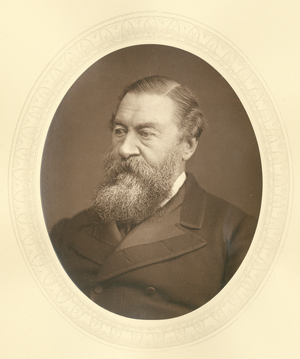The Albert N'yanza: Great Basin of the Nile, and Explorations of the Nile Sources. 2 vols. London: Macmillan and Co., 1866.
From my youth I had been inured to hardships and endurance in wild sports in tropical climates, and when I gazed upon the map of Africa I had a wild hope, mingled with humility, that, even as the insignificant worm bores through the hardest oak, I might by perseverance reach the heart of Africa.
—Baker, (Vol. 1, p. 1)
Baker evolved from sportsman, to explorer, to government official over a lifetime of travel and adventure. In 1848, he was responsible for establishing a successful English community in Ceylon (Sri Lanka) with his first wife (who died in 1855), two brothers, and friends. About a dozen years later, he was in the Ottoman Empire managing the construction of a railway between the Danube River and the Black Sea. On impulse, he attended a white slave auction in Vidin (Bulgaria) and rescued a teenage Transylvanian girl about to be sold. Florence Szász would become Baker’s inseparable traveling companion and eventual wife.
The couple explored in Abyssinia (Ethiopia) during 1861-1862 in preparation for a Nile expedition of their own. On 18 December 1862, they departed from Khartoum on three vessels as a party of ninety-eight, including forty-five armed men. In Gondokoro in February 1863, they met up with John Hanning Speke and James Augustus Grant, who were returning from their expedition up the Nile [see SPEKE]; Speke gave Baker his maps and information on a lake unknown to Europeans. The Baker party continued south, encountering hostility from slave and ivory traders and enduring the desertion of their men. Dependent on the help of a vakeel (agent) named Ibrahim, Baker and Florence finally reached the kingdom ruled by Kamrasi, north and west of Lake Victoria. The king’s extortions (including a demand for Florence) delayed them further, but with tremendous resolution Baker struggled southward. Sunstroke, Florence ultimately lapsed into a coma and had to be carried on a litter.
On 14 March 1864, they reached the shores of the lake Baker named Albert N’yanza after Queen Victoria’s late husband. They located the place where the White Nile entered the lake and not far upstream discovered and named the 120-foot high Murchison Falls. Baker and Florence were the first Europeans to reach this area (today’s northwestern Uganda), and their efforts finally solved the mystery of the White Nile’s route. The couple arrived back in Khartoum on 3 May 1865, and Baker was knighted in England for his achievement the following year. Later he would later be called back to Africa by the Ottoman viceroy to Egypt to assume command of a military expedition into the upper Nile region—but that is another story.
